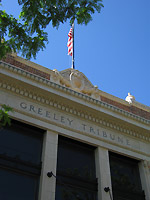Grant News
Greeley Floats Successful Preservation Project
Charles Hanson, the Colorado-Big Thompson Project and the Greeley Tribune Building
“In Colorado, water flows uphill, toward money.” That old saying—repeated often among the state’s lawyers and politicians—reflects the fact that most of Colorado’s precipitation falls as snow on the Western Slope, but eighty percent of the state’s population resides east of the Continental Divide. As early as the 1880s, some eastern slope folks began discussing ways to divert the water east, over the divide, and into irrigation ditches and municipal water systems. That dream became reality in the basement of the Greeley Tribune building in downtown Greeley.
The city of Greeley takes its water history seriously. Its historic preservation commission has listed a ditch, an artesian well, and a home once owned by an attorney specializing in water law in its local register of historic places. And the Greeley Tribune building, rehabilitated with assistance from the State Historical Fund, now houses the city’s museum and historic preservation office.
The Tribune, first printed by town founder Nathan Meeker in 1870, became the voice for transmountain water diversion in the early 1900s. Owner and editor Charles Hansen used it to convince farmers, local politicos, and businesspeople to support an audacious plan to siphon water from the headwaters of the Colorado River, shunt it beneath the Continental Divide via a tunnel, and pour it into a series of natural waterways, reservoirs, and ditches leading to the eastern plains.
Poet laureate Thomas Hornsby Ferril described Hansen as a quiet evangelist who “would talk in a low voice to anyone who would listen; then he would take you down in the basement of the Tribune and show you the worksheets, the preliminary drawings, the calculations. You would come away convinced that the project would somehow, some day, come into being.”
Someday turned out to be September 28, 1937, when Hansen presided over the first meeting of the Northern Colorado Water Conservancy District, the organization responsible for administering the Colorado-Big Thompson Project (C-BT). Built between 1938 and 1957, the C-BT now provides 213,000 acre-feet of water to thirty cities and 693,000 acres of farmland. The U.S. Department of the Interior’s Bureau of Reclamation transformed Hansen’s basement blueprints into twelve reservoirs, thirty-five miles of tunnels, ninety-five miles of canals, and seven hundred miles of electrical transmission lines. The C-BT is still the largest transmountain water diversion project in Colorado.
Such a project’s origins are worthy of remembrance. And where better to remember such an important historic project than the local museum. So, when the city of Greeley was looking for a new site to tell the region’s stories and house its most important historical treasures, the Greeley Tribune Building seemed a natural choice.
But it wasn’t perfect. The building, which had stood vacant since 1986 when the newspaper moved to a new facility, needed some work. Built in 1928, the Beaux-Arts landmark escaped the 1970s façade modernization craze that ruined other downtown commercial storefronts. However, its terra cotta tiles had begun to detach from the façade, masonry needed to be cleaned and repaired, and the iconic iron entry canopy needed to be restored. Inside, the lobby ceiling was in sad shape and the terrazzo floors required restoration.
Greeley’s preservation-savvy citizens, who had learned about the need to rehabilitate the downtown’s significant historic resources from the town’s nascent Main Street Program and the Historic Preservation Commission, approved a $4.25 million ballot measure that partially funded work on the Tribune Building in 2002. More than half a million of that went toward a cash match for a $200,000 State Historical Fund project to restore the building’s original Beaux-Arts beauty.
The 34,000 square-foot museum opened July 21 last year. It houses the museum’s archives and object collections, a museum store, community room, conference room, Hazel E. Johnson Research Center, historic preservation office, and several staff offices. And curators devoted a section of the permanent exhibition to the significance of water to the history of Greeley and Weld County. Charles Hansen, no doubt, would be pleased.

